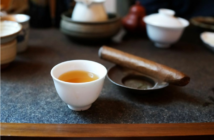Tea terminology can be mind-bogglingly complex, too. Which is why we have Tea A-Z, a guide to deciphering both common and completely bewildering concepts from the world of tea. Let’s dive in!
Afternoon Tea
Also called “low tea.” A primarily British custom, afternoon tea is a light meal eaten mid-afternoon, usually between 4-6 p.m., that consists of black tea served with finger sandwiches, scones, and other treats. Anna Maria Russell, the seventh Duchess of Bedford, is credited with popularizing afternoon tea starting in 1840, when she got too hungry before dinner at 8 p.m.
Aji
Literally, “flavor” or “taste.” This Japanese term is sometimes used to describe a characteristic of a traditional stoneware teacup as it’s used more and more: The more green tea is poured into the vessel, the more and deeper aji it develops—it literally gets better with use and age!
Anhui
A region of eastern China. The area produces a number of different teas, the most famous of which is Keemun black tea, originating in Qimen county.
Aroma
The fragrance or scent of brewed tea. Aromas are made up of vaporized essential oils and other chemical compounds, which are released when tea leaves are steeped in water or other hot liquids that act as a solvent. Aroma is considered an essential companion of taste, which is why inhaling adds to your enjoyment of your tea.
Assam
A state in northeastern India. Assam is known for its robust black teas, which are indigenous to the region and have a characteristic malty flavor; Assam black tea is the essential component of Irish Breakfast blends.
Astringency
A “dry” feeling in the mouth and on the tongue, caused by certain chemicals in brewed tea.



